The following guest post comes from Bitcoinminingstock.io, the one-stop hub for all things bitcoin mining stocks, educational tools, and industry insights. Originally published on Oct. 2, 2024, it was penned by Bitcoinminingstock.io author Cindy Feng.
In recent times, major tech companies such as Tesla, Google, Microsoft, and Amazon have all been undergoing significant layoffs. This trend is not confined to Silicon Valley; it spans various industries globally. Even X (formerly Twitter) saw around 80% of its employees depart after Elon Musk’s acquisition. Despite massive cuts, these platforms continue to function without any noticeable disruptions, raising questions about operational efficiency and cost management.
This trend led me to think: while Bitcoin mining companies are expanding their operations, upgrading fleets, or diversifying revenue streams to address smaller mining margins, how are they managing their non-essential business costs? Specifically, analyzing their General and Administrative (G&A) expenses relative to their revenue can provide valuable insights into their operational efficiency and cost management strategies.
Data Collection & Methodology
While I typically analyze all public Bitcoin miners listed on our platform, I focused on companies with over $100m market cap for the current report. Below is a summary of the data directly extracted from company filings.
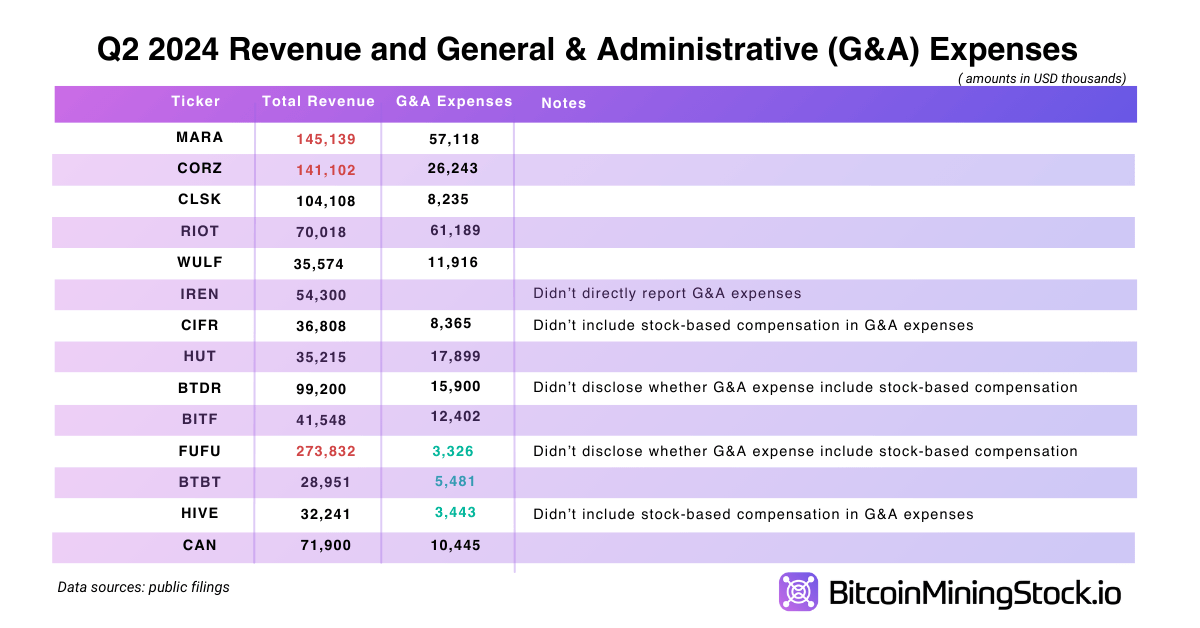
Revenue and General & Administrative Expenses Info for Publicly Listed Bitcoin Mining Companies (Market Cap> $100m)
Notes:
- Northern Data AG (NB2) and Applied Digital Corporation (APLD), though having over $100 million in market cap, were excluded due to the unavailability of Q2 2024 financial data.
- Companies define G&A expenses differently. Some include stock-based compensation, sales and marketing expenses, and consultation fees, while others exclude these items. The data presented is raw and directly extracted from the original sources.
Stock-Based Compensation and Adjusted G&A Ratios
10 out of 15 companies listed above include stock-based compensation in their G&A expenses. Since stock-based compensation often represents a significant portion of the G&A expenses, I also calculated an adjusted G&A ratio by excluding stock-based compensation. This provides a relatively fair view of how efficiently these companies manage their core administrative expenses.
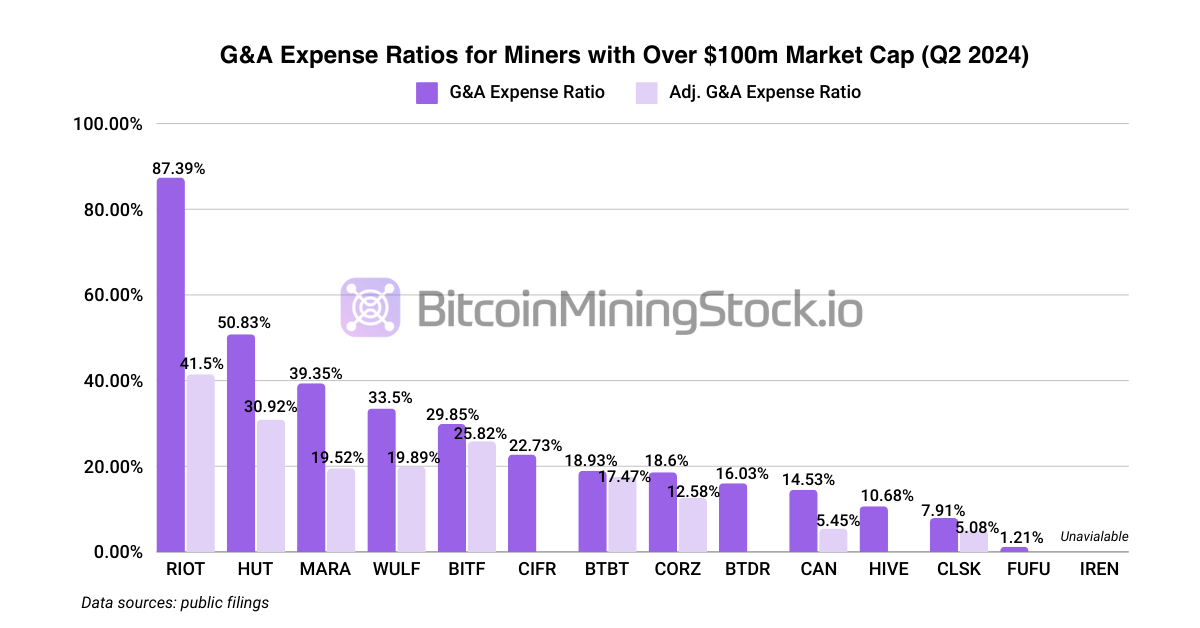
General & Administrative Expenses Ratios for Public Miners (Market Cap > $100m)
High G&A Expense Ratios
Riot Platforms Inc. (RIOT)
- G&A Expense Ratio: 87.39%
- Adjusted G&A Expense Ratio: 41.50%
RIOT’s G&A expenses are significantly higher than the benchmark of similar industries in the U.S (shown as below). The company’s expenses include stock-based compensation, legal and professional fees, and personnel-related costs.
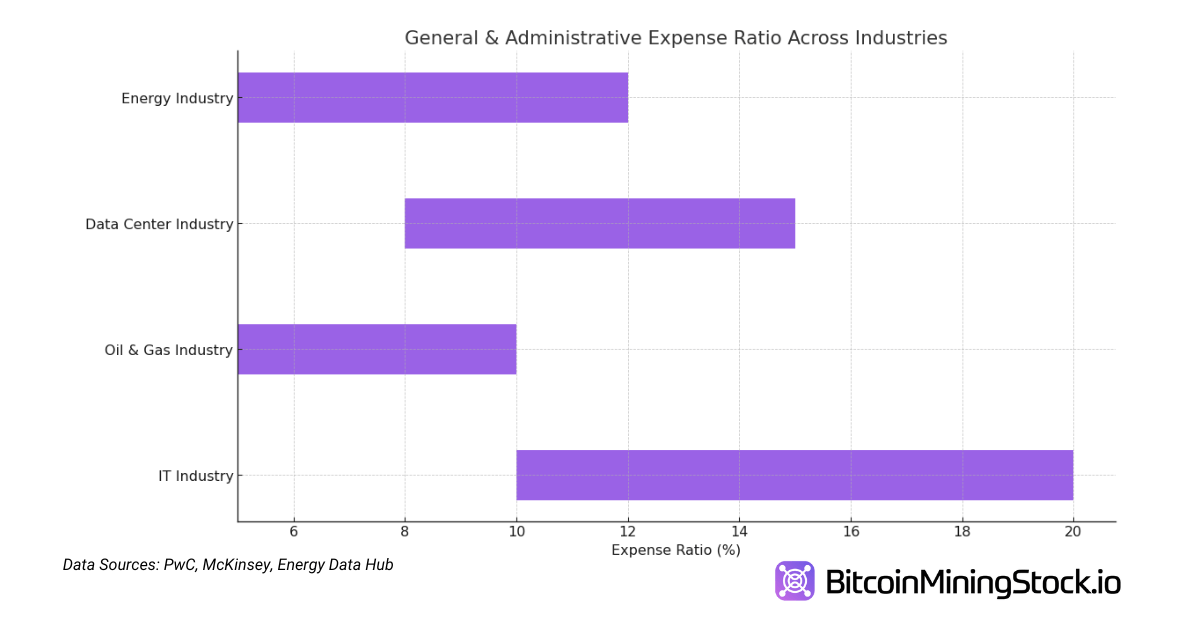
Typical General & Administrative Expense Ratio Ranges (in the U.S) Across Industries Similar to Bitcoin Mining
This elevated ratio may suggest:
- Inefficient Cost Management: High administrative costs without proportional revenue growth can indicate inefficiencies.
- Strategic Investments: The company might be investing heavily in long-term capabilities, such as new technologies and talent acquisition.
RIOT’s active acquisition activities could have temporarily increased G&A expenses due to integration costs and professional fees. However, without detailed context, it’s challenging to determine whether the high expenses stem from strategic initiatives or underlying inefficiencies.
Hut 8 Mining Corp. (HUT)
- G&A Expense Ratio: 50.83%
- Adjusted G&A Expense Ratio: 30.92%
HUT’s G&A expenses include payroll, stock-based compensation, legal fees, and other operational costs. Significant increases were due to:
- A $6.7 million rise in stock-based compensation.
- Expanded headcount from business combinations.
- Costs associated with relocating miners.
- Higher insurance and professional fees.
These expenses reflect HUT’s growth initiatives and the inherent costs of operating as a publicly listed entity. While these investments support expansion and strategic objectives, they also underscore the financial challenges of scaling operations and maintaining regulatory compliance.
MARA Holdings Inc (MARA)
- G&A Expense Ratio: 39.35%
- Adjusted G&A Expense Ratio: 19.52%
MARA experienced an 87% YoY increase in G&A expenses (excluding stock-based compensation), primarily due to:
- Business scaling and acquisitions.
- Increased payroll and benefits.
- Higher professional fees.
- Additional facility and equipment expenses.
Stock-based compensation rose from $4.5 million (Q2 2023) to $28.3 million (Q2 2024), driven by performance-based stock awards and a new long-term incentive program. The company’s headcount grew from 40 employees in June 2023 to 109 employees in June 2024, highlighting a talent-driven growth strategy.
While these investments demonstrate MARA’s commitment to expansion and attracting top talent, shareholders might question the sustainability of such overhead management, especially given the potential impact on profitability and shareholder value.
Lower G&A Expense Ratios
CleanSpark Inc. (CLSK)
- G&A Expense Ratio: 7.91%
- Adjusted G&A Expense Ratio: 5.08%
CleanSpark’s G&A expenses consist of property taxes, insurance premiums, payroll, and other corporate overhead costs. Though G&A Expense ratio is relatively low, its G&A expense grew by 62.65% compared to the same period of last year ($5.064m Q2 2023 vs $8.235m Q2 2024). In specific, A 65% increase in payroll expenses contributes to this increase, due to higher employee headcount and bonuses associated with expansion efforts. However, its stock-based compensation decreased from $5.95 million in Q2 2023 to $2.95 million in Q2 2024, attributed to the vesting of certain performance-based restricted stock awards in the prior period.
These expenses reflect CleanSpark’s growth initiatives and effective cost management. While the company achieved a significant 204.48% YoY in hash rate capacity as of June 30, 2024, it managed to control G&A expense ratio. Definitely keep an eye on future changes.
Canaan Inc (CAN)
- G&A Expense Ratio: 14.53%
- Adjusted G&A Expense Ratio: 5.45%
Known for its development and manufacture of ASICs, Canaan is also doing self-mining, although limited public information is available regarding this segment of its operations. The company has sequentially reduced its General and Administrative (G&A) expenses, decreasing from $17.3m in the same period last year to $14.3m in Q1 2024, and further down to the current $10.4m. This reduction was primarily achieved by cutting staff costs and share-based compensation expenses. As a result of these efforts and other financial management initiatives, including the reduction of G&A expenses, Canaan’s EBITDA has shown improvement compared to previous filings.
- G&A Expense Ratio: 1.21% *
BitFuFu’s exceptionally low G&A ratio is noteworthy, though it is unclear how they define their expenses. The company remains lightly traded with lack of analyst coverage, making its financials harder to evaluate comprehensively.
*After initially publishing this report, BitFuFu reached out and clarified that the company distributed restricted stock for the first time in September, resulting in zero stock-based compensation for Q2 2024. Therefore, BitFuFu’s G&A Expense Ratio is equal to the Adjusted G&A Expense Ratio in the current context.
Concerns Over Stock-Based Compensation
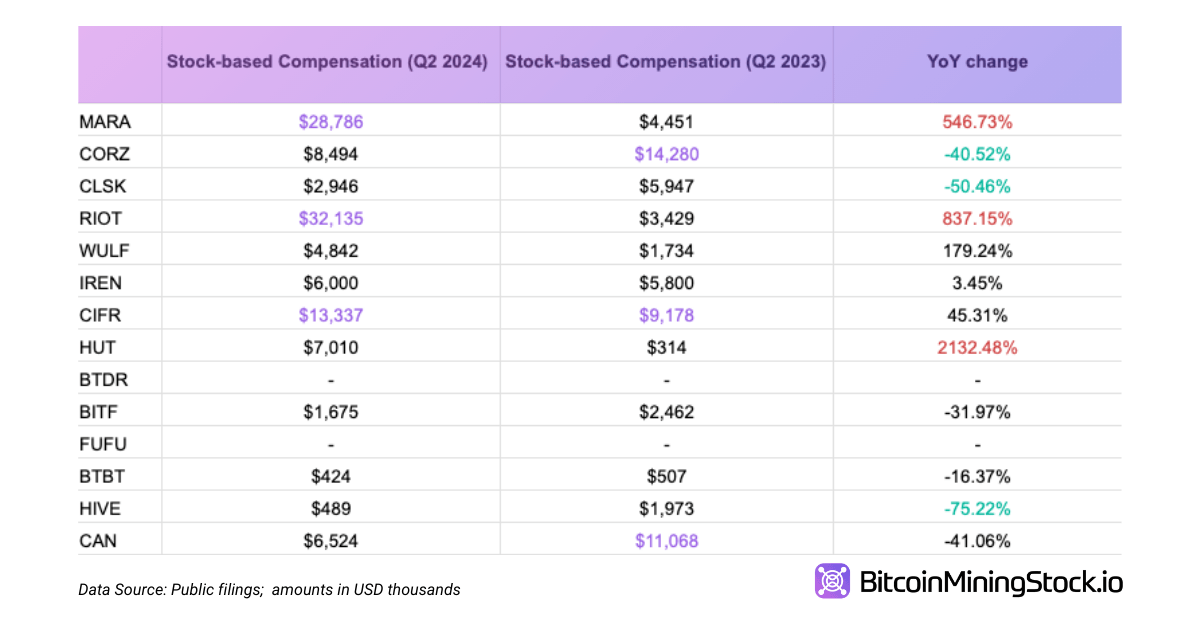
Stock-based Compensation Info for Publicly Listed Bitcoin Mining Companies (Market Cap > $100m)
I’ll briefly touch on stock-based compensation. Unlike cash rewards, stock options can be an effective way to attract top talent without draining cash reserves. Bitcoin companies seem to have high stock-based compensation ratios (shown as below). For instance, Riot Platforms (RIOT) reports a compensation ratio of 45.90%, while Cipher Mining (CIFR) , Hut 8 Corps. (HUT) and MARA Holdings (MARA) have ratios of 36.23%, 19.91% and 19.83%, respectively. This heavy reliance on equity-based rewards may attract talent, incentivize employees to focus on long-term growth and preserve company cash but can erode shareholder value if not matched by corresponding company performance.
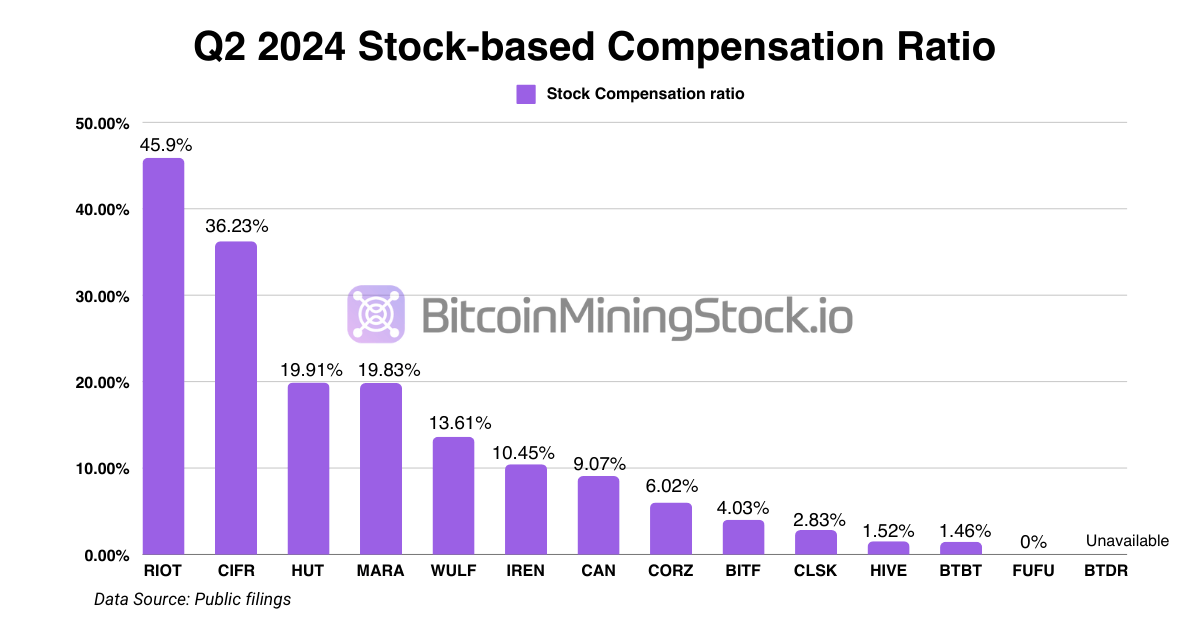
Stock-Based Compensation vs Total Revenue Ratio for Publicly Traded Bitcoin Mining Companies (Market Cap > $100m)
Companies like Bitdeer (BTDR) did not disclose their stock-based compensation figures in their quarterly reports, limiting investors’ ability to assess their financial practices. Overall, high stock-based compensation raises questions about whether such generous compensation strategies are sustainable or healthy for the industry’s long-term growth, especially during periods of turbulence and challenges.
Final Thoughts: The Road Ahead
As the Bitcoin mining industry continues to grow and evolve, financial management will remain critical in determining which companies thrive and which struggle. While investors often focus on direct production costs like electricity and equipment, other efficiency indicators, such as G&A expenses, can offer fresh perspectives on a company’s operational efficiency.
Ultimately, understanding how Bitcoin mining companies manage their G&A expenses can provide valuable insights into their overall strategy and financial health. Companies that demonstrate efficient overhead management without compromising growth are better positioned to navigate industry challenges and deliver sustained shareholder value.
The original version of this article can be found here.
免责声明:本文章仅代表作者个人观点,不代表本平台的立场和观点。本文章仅供信息分享,不构成对任何人的任何投资建议。用户与作者之间的任何争议,与本平台无关。如网页中刊载的文章或图片涉及侵权,请提供相关的权利证明和身份证明发送邮件到support@aicoin.com,本平台相关工作人员将会进行核查。



